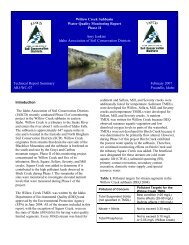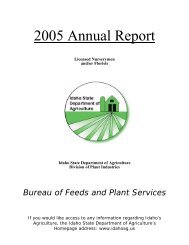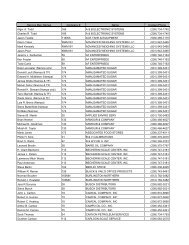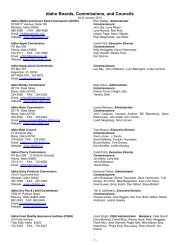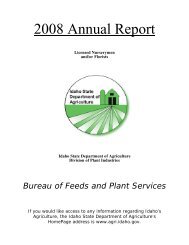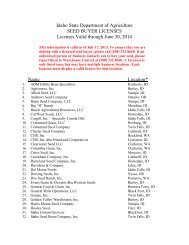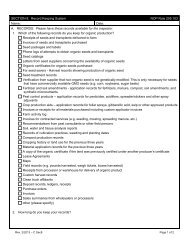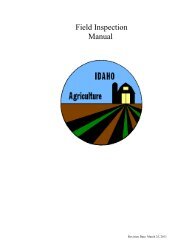2012 ISDA Grasshopper/Mormon Cricket Summary - Idaho ...
2012 ISDA Grasshopper/Mormon Cricket Summary - Idaho ...
2012 ISDA Grasshopper/Mormon Cricket Summary - Idaho ...
You also want an ePaper? Increase the reach of your titles
YUMPU automatically turns print PDFs into web optimized ePapers that Google loves.
<strong>Idaho</strong> State Department of Agriculture<br />
<strong>2012</strong> <strong>Grasshopper</strong> and <strong>Mormon</strong> <strong>Cricket</strong><br />
Suppression Program <strong>Summary</strong><br />
Introduction<br />
<strong>Grasshopper</strong>s and <strong>Mormon</strong> crickets continue to be one of the most serious pest problems for <strong>Idaho</strong><br />
rangelands and adjacent croplands. Based on annual surveys conducted by the United States<br />
Department of Agriculture (USDA), Animal Plant Health Inspection Service (APHIS), <strong>Idaho</strong> has<br />
experienced very serious pest outbreaks in previous years. The management and the timely control of<br />
grasshopper and <strong>Mormon</strong> cricket populations are high priorities for the <strong>Idaho</strong> State Department of<br />
Agriculture (<strong>ISDA</strong>) and our cooperators at USDA, APHIS. Congress has addressed this issue with special<br />
funding to the impacted states of <strong>Idaho</strong>, Utah and Nevada.<br />
Background<br />
Sixty-four percent of <strong>Idaho</strong> lands are administered by the Federal Government. Forty-three percent or<br />
21.8 million acres in <strong>Idaho</strong> is classified for use as rangeland. The Bureau of Land Management<br />
administers 11.8 million acres in <strong>Idaho</strong>, much of it prime grasshopper/<strong>Mormon</strong> cricket habitat. There is a<br />
significant area of grasshopper and <strong>Mormon</strong> cricket habitat on federal lands that borders private<br />
rangeland and irrigated cropland in the state. <strong>Mormon</strong> crickets and grasshoppers (primarily about six<br />
species) are cyclical economic pest problems, particularly in southern <strong>Idaho</strong>. In recent years, however,<br />
significant outbreaks have also occurred in north central and northern <strong>Idaho</strong>.<br />
<strong>Summary</strong> of <strong>Grasshopper</strong> Survey Results<br />
The grasshopper outbreaks in <strong>2012</strong> with damage to crops were very light compared to previous years. In<br />
<strong>2012</strong> the cool wet weather from April to late May kept soil temperatures lower than normal for the second<br />
consecutive spring. Emergence of first instar grasshoppers were delayed throughout the state and the<br />
infestations did not reach the population densities that were common in the years prior to 2011.<br />
<strong>Grasshopper</strong> populations were primarily a mixture of the Migratory <strong>Grasshopper</strong>, (Melanoplus<br />
sanguinipes), Twostriped <strong>Grasshopper</strong>, (Melanoplus bivitatus), Valley <strong>Grasshopper</strong>, (Oedaleonotus<br />
enigma), and Clearwinged <strong>Grasshopper</strong>, (Camnula pellucida) species. The requests for assistance from<br />
private landowners were due to grasshopper infestations instead of cricket or katydids. State lands in<br />
Boise and Owyhee Counties were treated by the (<strong>ISDA</strong>) for grasshopper infestations. The treatment of<br />
state lands in Owyhee County was limited due to the extreme fire hazard of <strong>2012</strong>. No environmental<br />
factors occurred in September or October of <strong>2012</strong> that would reduce the number of grasshoppers laying<br />
eggs from the current grasshopper population. The continued reduction in request for evaluations from<br />
private landowners in 2011 and <strong>2012</strong> indicates that limited grasshopper outbreaks and damage to crop<br />
production from grasshoppers may continue into the 2013 growing season.<br />
<strong>Summary</strong> of <strong>Mormon</strong> <strong>Cricket</strong> Survey Results<br />
The <strong>Mormon</strong> cricket, (Anabrus simplex), outbreaks continued to decrease in <strong>2012</strong> in comparison to 2011.<br />
No request for assistance from private landowners due to <strong>Mormon</strong> cricket infestations were received at<br />
<strong>ISDA</strong> in <strong>2012</strong>. Scouting of state lands by <strong>ISDA</strong> personnel did not find any <strong>Mormon</strong> cricket infestations that<br />
met the criteria to consider treatment of state lands.<br />
<strong>Summary</strong> of <strong>ISDA</strong> Program<br />
In <strong>2012</strong>, <strong>ISDA</strong> continued to suppress outbreaks of grasshoppers. No suppression of <strong>Mormon</strong> crickets and<br />
related katydids were necessary in <strong>2012</strong>. Forty-two private landowners in 15 counties received assistance<br />
in the form of 35,550 lbs. of bait valued at $28,440 in <strong>2012</strong>, a decrease of 56,600 lbs. in bait distributed in<br />
2011 to private landowners. No cost-share spray projects were conducted in <strong>2012</strong> for this program. In<br />
addition, <strong>ISDA</strong> protected 267 acres on impacted state lands in Boise and Owyhee Counties. For<br />
additional information, go to the <strong>ISDA</strong> website www.agri.idaho.gov and search under the Plants and<br />
Insects tab for the <strong>Grasshopper</strong>/<strong>Mormon</strong> <strong>Cricket</strong> Program.<br />
<strong>2012</strong> <strong>ISDA</strong> <strong>Grasshopper</strong> and <strong>Mormon</strong> <strong>Cricket</strong> Suppression Program <strong>Summary</strong> Page 1 of 5
<strong>2012</strong> COST-SHARE PROJECTS WITH PRIVATE LANDOWNERS FOR GRASSHOPPER SUPPRESSION – NONE<br />
CONDUCTED IN <strong>2012</strong><br />
Project<br />
Location<br />
Acres<br />
Treated<br />
Total<br />
Protected<br />
Acres<br />
Insecticide<br />
Cost to<br />
<strong>ISDA</strong><br />
(1/2)<br />
Cost to<br />
Private<br />
Landowner<br />
(1/2)<br />
Total<br />
Project<br />
Cost<br />
Cost Per<br />
Acres<br />
Protected<br />
Totals 0 0 0 0 0<br />
<strong>2012</strong> CARBARYL GROUND TREATMENTS ON COUNTY ROAD RIGHTS-OF-WAY AND STATE LANDS<br />
Boise 250 Lbs. 24 Acres<br />
Owyhee 2,400 lbs. 243 Acres<br />
Total 2,650 lbs 267 Acres<br />
MULTI-YEAR SUMMARY OF CARBARYL TREATMENTS ON COUNTY ROAD RIGHTS-OF-WAY AND STATE<br />
LANDS<br />
Total Pounds Applied<br />
Acres Treated<br />
Year<br />
2005 12,175 1,218<br />
2006 6,612 661<br />
2007 3,906 340<br />
2008 3,750 194<br />
2009 21,200 1,446<br />
2010 4,300 428<br />
2011 900 92<br />
<strong>2012</strong> 2,650 267<br />
<strong>2012</strong> <strong>ISDA</strong> <strong>Grasshopper</strong> and <strong>Mormon</strong> <strong>Cricket</strong> Suppression Program <strong>Summary</strong> Page 2 of 5
<strong>2012</strong> BAIT DISTRIBUTIONS TO PRIVATE LANDOWNERS FOR GRASSHOPPER SUPPRESSION<br />
Rank<br />
County<br />
Carbaryl Bait<br />
Distributed (lbs)<br />
Number of<br />
Distributions<br />
1 Valley 8,850 8<br />
2 <strong>Idaho</strong> 7,850 9<br />
3 Gem 5,000 2<br />
4 Ada 3,550 1<br />
5 Clearwater 2,500 6<br />
6 Washington 2,100 2<br />
7 Franklin 1,500 5<br />
8 Owyhee 1,200 1<br />
9 Bonner 1,050 2<br />
10 Oneida 1,000 1<br />
11 Bannock 500 1<br />
12 Adams 150 1<br />
13 Boise 100 1<br />
Kootenai 100 1<br />
Nez Perce 100 1<br />
Totals 15 Counties 35,550 42<br />
<strong>2012</strong> <strong>ISDA</strong> <strong>Grasshopper</strong> and <strong>Mormon</strong> <strong>Cricket</strong> Suppression Program <strong>Summary</strong> Page 3 of 5
<strong>2012</strong> <strong>ISDA</strong> <strong>Grasshopper</strong> and <strong>Mormon</strong> <strong>Cricket</strong> Suppression Program <strong>Summary</strong> Page 4 of 5
<strong>ISDA</strong>, Division of Plant Industries, Carbaryl Bait Distribution to Private<br />
Land Owners for <strong>Grasshopper</strong> and <strong>Mormon</strong> <strong>Cricket</strong> Suppression<br />
11 Year Average = 217,054<br />
MAJOR COOPERATORS FOR THE GRASSHOPPER/MORMON CRICKET PROGRAM<br />
During the <strong>2012</strong> season, the following cooperators provided significant help in bait distributions<br />
and overall program delivery:<br />
‣ University of <strong>Idaho</strong>, Extension Service, Elmore County<br />
‣ University of <strong>Idaho</strong>, Extension Service, Franklin County<br />
‣ Randy Rowe Trucking Company, Twin Falls, ID.<br />
‣ Primeland Cooperative, Grangeville, ID.<br />
Program Contacts: <strong>ISDA</strong>, Plant Industries Division<br />
Dick Lawson, Program Specialist, dick.lawson@agri.idaho.gov; 208.332.8620<br />
Garry West Program Manager, garry.west@agri.idaho.gov; 208.736.2195<br />
Mike Cooper, Bureau Chief, mike.cooper@agri.idaho.gov, 208.332.8620<br />
Breann Hipwell, Technical Records Specialist, breann.hipwell@agri.idaho.gov; 208.332.8650<br />
<strong>2012</strong> <strong>ISDA</strong> <strong>Grasshopper</strong> and <strong>Mormon</strong> <strong>Cricket</strong> Suppression Program <strong>Summary</strong> Page 5 of 5



